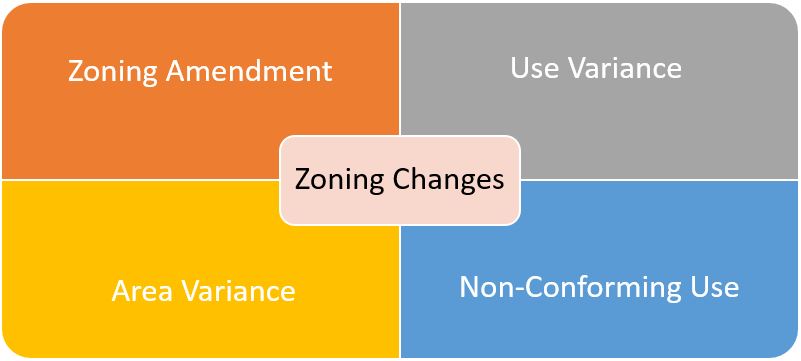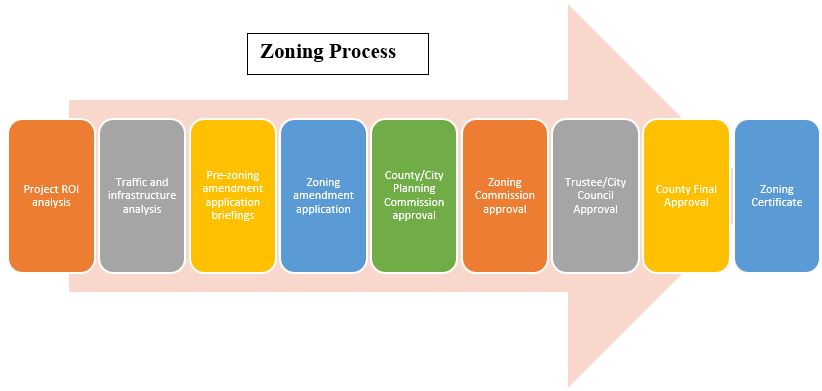Zoning is a key component of the basic system of land use regulation. Unincorporated land and rural communities operate with less zoning authority. Zoning regulations provide for orderly growth, generally in furtherance of comprehensive plans; limit the interaction of incompatible uses; and protect the public health, safety, and welfare. The constitutionality of zoning regulation, as an exercise of the police power, is established by the Supreme Court in the 1920s and conventional zoning creates neighborhoods with five key components:
- Housing subdivisions;
- Shopping centers, composed of single-use retail buildings, usually a single story with exclusive parking areas;
- Office/business parks, also single use and served by exclusive parking areas;
- Civic institutions, such as churches, schools, and libraries, generally large and separated from other uses and served by exclusive parking areas; and
- Roadways connecting these separated land uses and designed exclusively for the use of automobiles.
Economic development projects that need to change the zoning at their site can achieve that zoning change through the use of a zoning amendment, use variance, area variance or non-conforming use.
Andres Duany, Elizabeth Plater–Zyberk, and Jeff Speck, Suburban Nation: The Rise of Sprawl and the Decline of the American Dream (Union Square West, NY: North Point Press, 2000), 5–7.

A zoning amendment is the rezoning of a parcel (s) from one zoning category to another that better permits the intended use of the land. As an example, a site that is currently zoned to permit agriculture will need to be rezoned to a manufacturing or logistics category to permit that site to be transformed into an industrial park. Many regions have created special zoning categories for industrial parks that contain a full package of zoning mandates consistent with the land use, building heights, roadway access and other issues relevant to special industries such as logistics.
Changes to the use of property can also be achieved through the variance process. A use variance is a request to deviate from current zoning requirements, and it permits the owner to use the land in a manner not otherwise permitted by the zoning ordinance. Area variances are also permitted the depart from the zoning code for size and setback requirements. This type of variance is held to a lesser standard, and property owners seeking an area variance must only prove the zoning ordinance creates “practical difficulties” for the burdened parcel. A variance is a specific waiver form the zoning ordinance, and standards for awarding a variance focus on whether the property owner can demonstrate that existing zoning regulations present a practical difficulty in making use of the property. The process for awarding a variance is similar to that of gaining a zoning amendment. A zoning variance application must be filed and notice is provided to adjacent property owners. Public hearings by a city planning or development commission or a township zoning commission prior to the final decision by the city council or township trustees are held with recommendations provided by the planning or zoning commission and the final decision resting with the city council or township trustee.
Many successful zoning change applications start with an aggressive preapplication approach that begins with meeting the local government zoning staff and impacted community. Early completion of traffic and engineering studies pay big dividends later. Next, those seeking zoning changes obtain written service commitments for public sewer and water services, engineering approval of the legal description, and outline of the economic model and time constraint for the project. The project may then be prepared to file a zoning application. The zoning application includes a statement of compliance to the comprehensive plan applicable to the area, detailed legal descriptions of all subareas, site plans, elevations, and construction materials palette. Project drawings illustrate how the proposed development “fits in.” Also, the zoning applicants provide certification of financial capability to execute the project if approved and a vicinity map showing names of neighbors.

Notice is then provided to all persons mandated by the zoning ordinance/resolution, mailed to the tax mailing or street addresses, through publication in a newspaper of general circulation or posting a sign(s) on the property. Once the zoning application is received by the zoning official, the staff reviews for accuracy and completeness and hearing is held before a regional planning commission. A written recommendation to the jurisdictions planning commission is then created, and ultimately a vote is taken on the zoning by the city council or township trustees. However, in many jurisdictions the citizens still retain the right to place a referendum on the ballot to overturn the zoning action by city council.